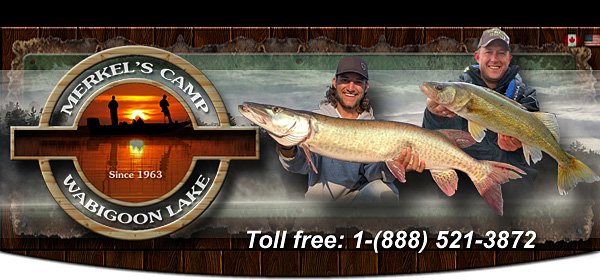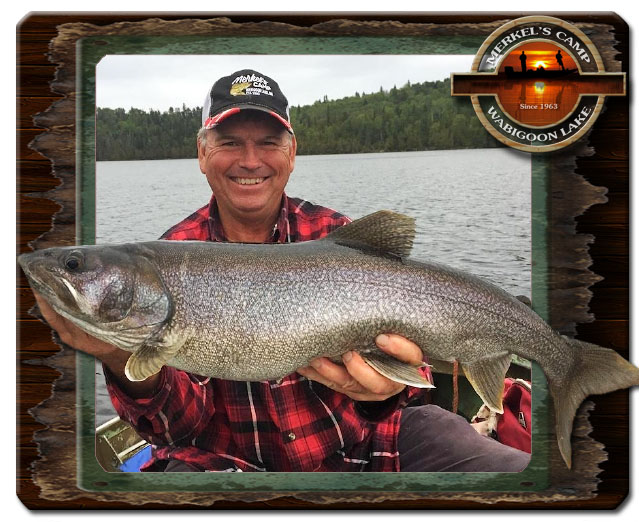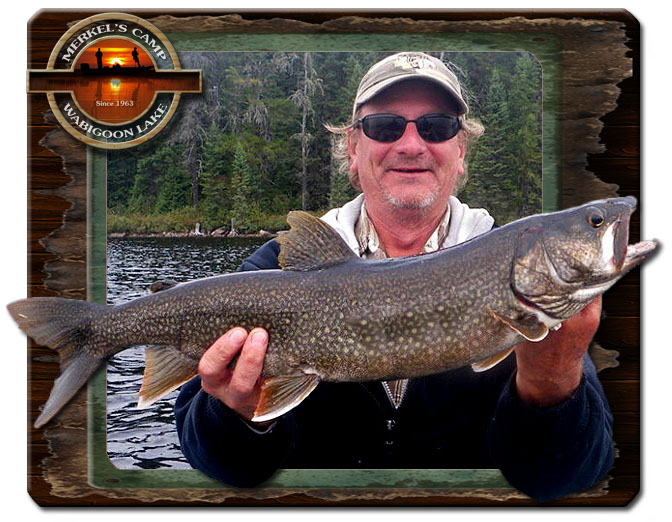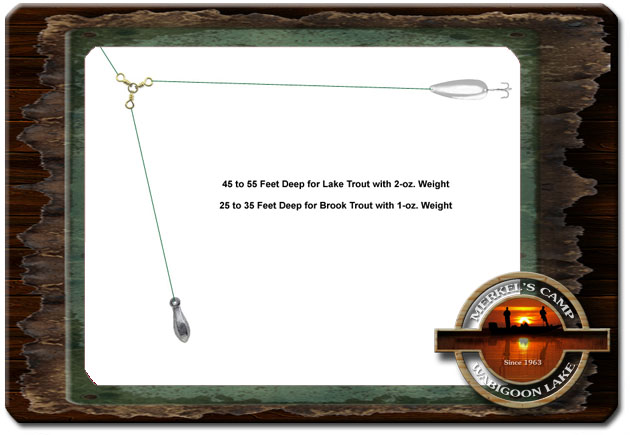



If you are new to Lake Trout fishing then we can easily assume that many of the things that you have heard about Lake Trout are not accurate. It's a fish that is surrounded by negative folklore and because of this it's a resource that has not been enjoyed by all.
Lake Trout are a ton of fun to catch and they taste fantastic. They have a mild flavor that is far superior to Rainbow Trout or Salmon. They are a hard fighting predator and can reach great sizes. The secret is to know how to catch them with light equipment. In the old days people used lead-core line and heavy bait-walkers but if you read our light tackle Lake Trout tips you will become an expert at catching Lake Trout and all you need is your Walleye or Pike rod.
People that are into Lake Trout fishing often become fanatical because it's so much fun. Bringing a big heavy hard-fighting fish up from the depths almost feels mystical and the anticipation of seeing what you have on your line will get your heart pounding. Even though most of the Lake Trout you will catch in our area will be between 2 and 6 pounds, that does not mean you can't hook into something much bigger. Basket Lake and Little Basket Lake, where our outpost cabin is located, is a lake system that has enough food and is big enough to support trout over 30 pounds. There are many other lakes within an hour's drive of camp that have great Lake Trout fishing as well. If staying at our main camp, we highly recommend making a day-trip for lakers. If you are planning on staying at our outpost camp, you should bring some Lake Trout spoons, 3-way swivels and 2-oz. weights.
How many Lake Trout you can catch in a day is impossible to predict. They are extremely sensitive to changes in pressure and if a low-pressure system comes into the area they may stop feeding for days. Generally if we have had nice sunny weather with high pressure the trout will be biting. Some days the small ones are hitting and bringing in 10 trout in an afternoon would be a great day. When the really big trout are feeding the smaller ones slow down. If conditions seem perfect and the small ones are not biting, then be prepared to get an old lunker on your line. A big Lake Trout is something you will never forget for the rest of your life. Each year guests report catching-&-releasing trout over 10 pounds.

Lake Trout are a resource that few people take advantage of. One of the big reasons is people don't like to fish with the traditional equipment and don't find any luck fishing with traditional methods. Lake Trout are a ton of fun to catch on light-action equipment and they also taste fantastic and have a mild taste that is far superior to Rainbow Trout or Salmon. With the methods below you will discover that Lake Trout are not hard to catch and can be so much fun. Bringing a big heavy fish up from the depths creates a level of excitement that is hard to put into words and a great addition to the adventure-factor of your vacation.
Spring Lake Trout Tactics:
In the spring from Ice-out to a couple weeks after the Lake Trout are right under the surface. This is when guests catch most of them and have fun catching them on their Walleye rod. This seems to be the best time of year to catch them but to experienced Lake Trout hunters, the spring is actually one of the hardest times to catch them because they are spread out all over the lake and not concentrated in the holes or just above the thermocline.
If you do find yourself fishing on a lake in early spring and you know there are Lake Trout then the best thing to do is find a shoal, sandy bay or a sandbar. In the spring, the water warms up faster over sandy shallow areas and this attracts minnows. The Lake Trout don't like the warm water but will sit off the shoals or sandbars in deeper darker water waiting for minnows to venture out to the edge where they are easy to pick off. Casting with Little Cleos and spinners is the best way to get them. The Lake Trout will also be moving along the shore looking for minnows. In this case you may want to troll for them.
In the spring Lake Trout are very sensitive to the sound of the motor. Long line trolling behind the boat is very effective. As you troll into the area the Lake Trout will move out to the sides and they can quickly move 50 feet or more to give your boat a wide birth. With this in mind try casting out behind the boat at a 45 degree angle and then let the boat pull the line straight and then slowly let line out behind the boat. You will catch 10 times as many trout casting out sideways vs. just dragging a lure behind the boat. Even if you are using an electric motor you will still find more success casting out sideways.
Deep Water Summer Lake Trout Tactics:
In late spring the Lake Trout will be in a transition stage where they are found at different depths but by the time summer rolls around the Lake Trout will move down deep. In small lakes the Lake Trout will be located in the deeper holes and spend most of the summer near springs. In bigger lakes the Lake Trout generally stay just above the 53-degree thermocline. Lake Trout will go below the thermocline but oxygen levels are much lower and the Lake Trout go dormant and do not feed as often as the trout above the thermocline. The thermocline is usually located between 45 and 60 feet deep on inland lakes.
Traditional methods for fishing down deep are using lead-core line, downriggers, bait-walkers and Dipsy Divers. All these methods will catch fish but they are flawed and not very effective or they are not fun. If you have a small fishing boat then the best way to fish for Lakers is to back-troll as slow as you can with a 3-way swivel, 8-15lb test line and your Walleye stick. To fish 50 feet deep you need a 2 oz. weight and a light flutter spoon such as a Sutton Silver Spoon or a MooseLook Spoon. There are hundreds of light flutter spoons on the market. Dark blue & silver, dark green and silver and just silver are the best colors on bright sunny days. If the sky is little cloudy than go to a copper colored spoon. If a low pressure system comes in go Walleye fishing as the trout will not be feeding.

Tie 2 feet of line from your 3-way swivel to a regular clip swivel and then attach your lure. Then tie another 2.5 feet of line from your 3-way swivel to your 2-oz. weight. Get a slow back-troll and slowly let line out a foot at a time. If you are traveling slow your line should be almost straight down. Letting out about 55 feet of line means you should be down around 50 feet. One full reverse reel should be about one foot of line on most reels. You will need a depth finder to mark what depth the fish are at. Using this heavy weight, your lure should be in your depth finders cone. This places your bait as your seeing the fish on your locator. Lake Trout are usually around 50 feet deep in the summer but in the evening will come shallower and sometimes can be found as shallow as 35-feet deep in the summer. In a small spring-fed Lake the Lake Trout could be shallow all year.
You want to use dark green line as it has low visibility. You want the line to your sinker to be a little bit longer than the line to your lure so that if you get a snag your lure stays off the bottom and does not get snagged as well. Just troll until you get a hit. When using a 3-way swivel you have to set the hook hard. Keep your drag set properly and if the fish wants to take off and rip 50 feet of line off your reel, let him.
Lake Trout hit best first thing in the morning and in the evening. During the day they will turn on-and-off like a light switch and some times they will only feed for 10 or 15 minutes and then stop dead again. You just have to be out there trolling and hope that they start feeding. Lake Trout like bright sunny weather with high pressure. A low pressure system can cause them to stop feeding for days. They are a challenge to catch on bigger lakes. Just a short drive from camp are a number of small Lake Trout lakes that are stuffed with trout and you will find great success using these light tackle methods. There is less food in smaller lakes so the Lake Trout are more often feeding than not.